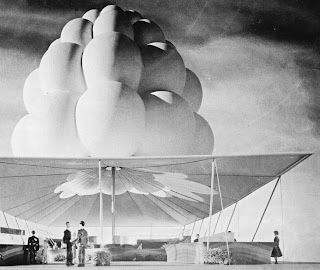Bubble architecture was the premise for the Suitaloon and Cushicle.
 |
| Above, Page 12 of Archigram 4: Zoom; Below, Page 13 |
The interest in bubble architecture ignited with the post-war
science fiction genre. Inventive technologies for zero gravity, midcity, midair and underwater were being imagined just as such things were becoming possible. Pneumatic technology advanced and gave bubbles sci-fi credibility. Suddenly, the bubble was the ideal living condition of the post-war era.
Bubbles became popular as enclosures for exhibitions. Possessing no structural members, they overcame conventional building technology, were cheap and had variable perimeter. Being light, were a fast easy way to cover large areas. For designers, the constantly churning fan inflating the membrane created fascinating tension between perfect mathematical form and formlessness. The thin membrane challenged the definition of ‘enclosure’. The structure reacts to changes in the environment like wind and rain. Unlike tents or inflatables, the self regulated membrane has no skeleton and will float away before collapsing in. In comparison, even capsule architecture seems heavy.
Bubbles became popular as enclosures for exhibitions. Possessing no structural members, they overcame conventional building technology, were cheap and had variable perimeter. Being light, were a fast easy way to cover large areas. For designers, the constantly churning fan inflating the membrane created fascinating tension between perfect mathematical form and formlessness. The thin membrane challenged the definition of ‘enclosure’. The structure reacts to changes in the environment like wind and rain. Unlike tents or inflatables, the self regulated membrane has no skeleton and will float away before collapsing in. In comparison, even capsule architecture seems heavy.
Downfalls which prevent the use of membranes as enclosure include the lack of any rigid form and disturbing instability when the air
currents are interrupted by walking people or environmental factors. The fans they
required to stay inflated can be very loud.
 |
| Archigram's Seaside Bubbles |
In 1956, James Stirling had already exhibited a sculpture extrapolated from the form of soap bubbles at the This Is Tomorrow exhibition and Victor Lundy’s Atoms of Peace Pavillion (1960) was shaped like two conjoined bubbles. The idea was already explored when Archigram entered.
In Archigram 3, bubbles were introduced as a form of expendable architecture. In Archigram 4 (1964) Bubbles were explored as a facet of science fiction. Among other Archigram projects, Ron Herron’s 1966 pneumatic ‘Seaside Bubbles’ explored the explored a modular and
pliable environment. Micheal Webb’s 1967 Suitaloon distilled the bubble dwelling. With an ultra thin membrane, reactive attachment to other bubbles and skin-like organic structure the Suitaloon is literally a personal bubble.
 |
| Sculpture by James Stirling (1956) |
 |
| Victor Lundy's Air supported structure (1955) |


